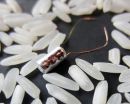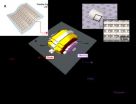(Press-News.org) There are three common drugs for advanced ovarian cancer: paclitaxel, cyclophosphamide, and topotecan. Like a shell game, if you pick the right drug a patient is likely to respond. And, unfortunately, picking the wrong drug can lead to treatment failure. As reported in this month's issue of the journal PLoS ONE, a University of Colorado Cancer Center and University of Virginia study used a sophisticated model of ovarian cancer genetics to match the right tumor with the right drug. Patients who were matched in this way lived an average 21 months longer than patients who were not matched.
Because it has been so difficult to predict which ovarian cancers will respond to each of these three drugs, doctors have largely been forced to guess which will work best – and so in this study of four groups of 783 patients each, some were accidentally given what would turn out to be the best possible drug whereas others were given one of the two other, less good drugs. The model, called COXEN (CO-eXpression gENe analysis), sorts through the massive genetic data of thousands of tumor samples to discover differences between tumors that responded and tumors that did not.
"The model allowed us to ask what would have been the right drug in each case, how could we have known from the tumor's genetics, and what difference it made," says Jennifer R. Diamond, MD, CU Cancer Center investigator and medical oncologist at the University of Colorado Hospital.
When COXEN looked back through this registry of advanced ovarian cancer, it first sorted tumors into those that had responded and those that had not responded to each drug ("what would have been the right drug in each case"). It then pinpointed genetic signatures of tumors that responded to each drug ("how could we have known from the tumor genetics"). And the study finally showed that patients who had been serendipitously given the drug that the COXEN model would have picked for them lived 21 months longer than the average patient with advanced ovarian cancer.
"We have traditionally considered site-specific cancer to be homogenous – one ovarian cancer is like the next ovarian cancer. But we are increasingly learning that isn't the case at all. The COXEN model allows us to identify the heterogeneity within the disease. It lets us see why some ovarian cancers respond and others don't," Diamond says.
Diamond is also quick to point out that while the current study shows that COXEN could have been used to predict the most useful drug in many of these cases of advanced ovarian cancer, the actual use of the model will be possible only after validation with a prospective clinical trial. In fact, a similar strategy led to similar results in bladder cancer, and a prospective clinical trial of COXEN in bladder cancer is underway at the CU Cancer Center and elsewhere.
"This study supports the idea that we could test ovarian cancer tumors and say they're more likely to respond to one or the other drugs," Diamond says.
INFORMATION: END
COXEN model picks the best drug for ovarian cancer
2014-02-18
ELSE PRESS RELEASES FROM THIS DATE:
A battery small enough to be injected, energetic enough to track salmon
2014-02-18
RICHLAND, Wash. – Scientists have created a microbattery that packs twice the energy compared to current microbatteries used to monitor the movements of salmon through rivers in the Pacific Northwest and around the world.
The battery, a cylinder just slightly larger than a long grain of rice, is certainly not the world's smallest battery, as engineers have created batteries far tinier than the width of a human hair. But those smaller batteries don't hold enough energy to power acoustic fish tags. The new battery is small enough to be injected into an organism and holds ...
Controlling magnetism with an electric field
2014-02-18
Coral Gables, Fla. (Feb. 17, 2014) -- There is a big effort in industry to produce electrical devices with more and faster memory and logic. Magnetic memory elements, such as in a hard drive, and in the future in what is called MRAM (magnetic random access memory), use electrical currents to encode information. However, the heat which is generated is a significant problem, since it limits the density of devices and hence the performance of computer chips.
Scientists are now proposing a novel approach to achieve greater memory density while producing less heat: by using ...
University of Illinois study of 2011 flood will lead to better preparedness
2014-02-18
In May 2011, when the U.S. Army Corps of Engineers used explosives to breach a levee south of Cairo, Ill., diverting the rising waters of the Mississippi and Ohio rivers to prevent flooding in the town, about 130,000 acres of Missouri farmland were inundated. It was the largest flood of the lower Mississippi ever recorded, and researchers from the University of Illinois at Urbana-Champaign took advantage of this "once-in-a-scientific-lifetime" occurrence to study the damage, funded by a National Science Foundation Rapid Response Grant. Their results, published this week ...
Embarking on geoengineering, then stopping, would speed up global warming
2014-02-18
Spraying reflective particles into the atmosphere to reflect sunlight and then stopping it could exacerbate the problem of climate change, according to new research by atmospheric scientists at the University of Washington.
Carrying out geoengineering for several decades and then stopping would cause warming at a rate that will greatly exceed that expected due to global warming, according to a study published Feb. 18 in Environmental Research Letters.
"The absolute temperature ends up being roughly the same as what it would have been, but the rate of change is so drastic, ...
In fight against teen prescription drug abuse, one-two punch wins
2014-02-18
DURHAM, N.C. -- Programs that aim to curb teen prescription drug abuse have vastly differing effectiveness, ranging from big drops in drug abuse to no measurable effect, according to a new study of 11,000 teenagers by researchers at Duke and Pennsylvania State universities.
The best results came from pairing a school-based program with a home-based intervention, resulting in a 10 percent decrease in abuse rates. By contrast, most school-based programs were ineffective when used by themselves, with just one exception.
The six-year study is among the first to measure ...
Research team establishes benchmark set of human genotypes for sequencing
2014-02-18
Led by biomedical engineer Justin Zook of the National Institute of Standards and Technology, a team of scientists from Harvard University and the Virginia Bioinformatics Institute of Virginia Tech has presented new methods to integrate data from different sequencing platforms, thus producing a reliable set of genotypes to benchmark human genome sequencing.
"Understanding the human genome is an immensely complex task and we need great methods to guide this research," Zook says. "By establishing reference materials and gold standard data sets, scientists are one step closer ...
Smartphone app aids college-age women in abusive relationships
2014-02-18
COLUMBIA, Mo. –Women between the ages of 18 and 24 are at the highest risk for dating violence, according to the Centers for Disease Control and Prevention. However, these women are less likely than older adults to seek formal safety resources and instead look to peers or technology for help and advice. In an effort to connect more young women with safety information, University of Missouri researchers collaborated with Johns Hopkins University School of Nursing and the One Love Foundation to develop the "One Love My Plan" smartphone application, an interactive tool that ...
Breakthrough development of flexible 1D-1R memory cell array
2014-02-18
With the introduction of curved smartphones, flexible electronic goods are gradually moving to the center stages of various markets. Flexible display technology is the culmination of the latest, cutting-edge electric cell device technology. Developing such products, however, requires not only a curved display, but also operational precision of other parts, including the memory, in a flexible state.
Dr. Tae-Wook Kim at KIST announced their successful development of a 64-bit memory array using flexible and twistable carbon nano material and organo-polymer compound, which ...
Medicare beneficiaries return to emergency rooms after nursing home discharge
2014-02-18
Nursing homes are widely used by Medicare beneficiaries who require rehabilitation after hospital stays. But according to a recent study led by a researcher at the University of North Carolina at Chapel Hill School of Nursing, a high percentage of Medicare patients who are discharged from nursing homes will return to the hospital or the emergency room within 30 days.
"Nearly two million older adults use this benefit every year," said assistant professor Mark Toles, the first author of the study. "Before this study, we didn't recognize the large number of older adults ...
Healthy Lunchbox Challenge helps influence healthy eating habits in children
2014-02-18
AUDIO:
Falon Tilley and Michael W. Beets discuss the successful implementation of the Healthy Lunchbox Challenge, an innovative theory and incentive-based program, at four large-scale, community-based summer day camps. They observed...
Click here for more information.
PHILADELPHIA, PA, February 18, 2014 – During the school year, 21 million children receive free or reduced-price lunches, yet less than 10% of those children participate in the Department of Agriculture's Summer ...




